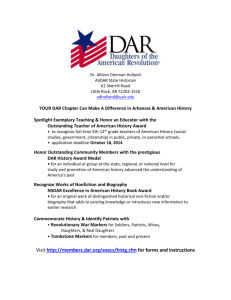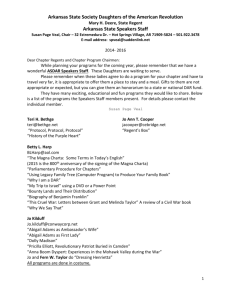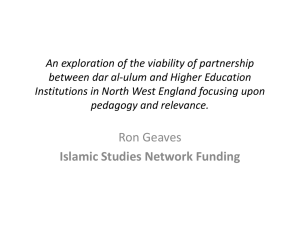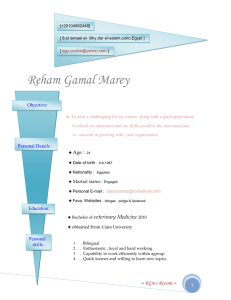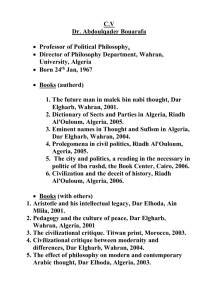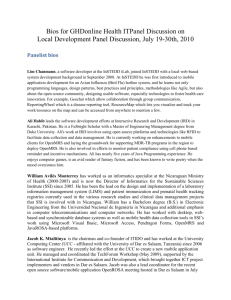Becoming a DAR - Rainbow Aviation
advertisement
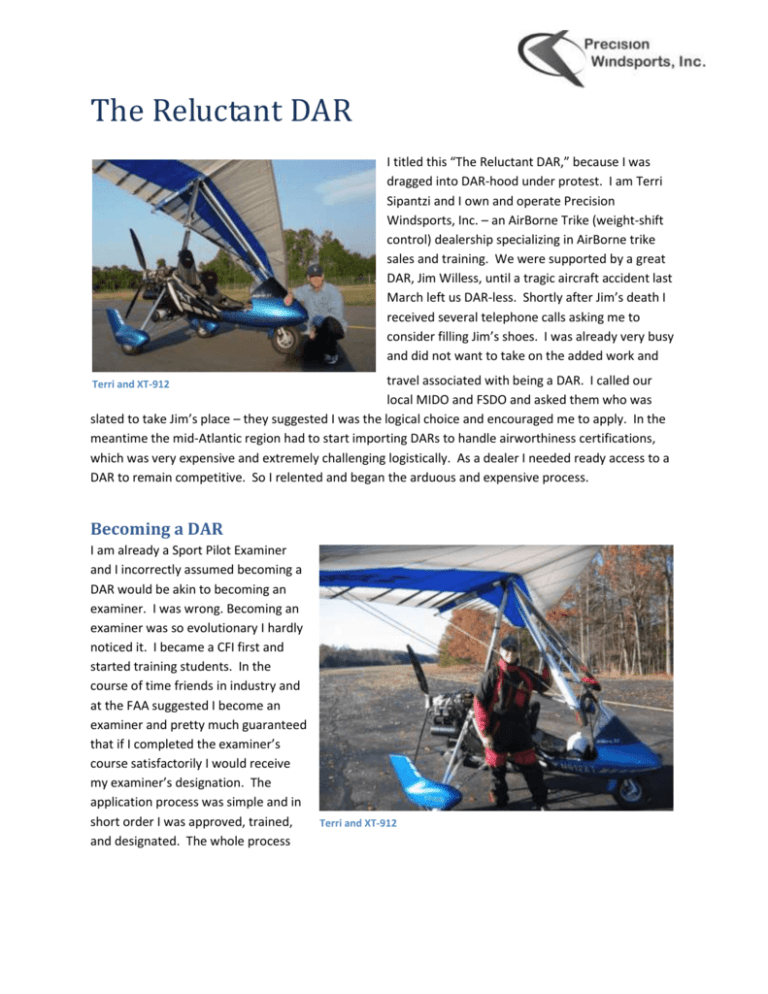
The Reluctant DAR I titled this “The Reluctant DAR,” because I was dragged into DAR-hood under protest. I am Terri Sipantzi and I own and operate Precision Windsports, Inc. – an AirBorne Trike (weight-shift control) dealership specializing in AirBorne trike sales and training. We were supported by a great DAR, Jim Willess, until a tragic aircraft accident last March left us DAR-less. Shortly after Jim’s death I received several telephone calls asking me to consider filling Jim’s shoes. I was already very busy and did not want to take on the added work and travel associated with being a DAR. I called our local MIDO and FSDO and asked them who was slated to take Jim’s place – they suggested I was the logical choice and encouraged me to apply. In the meantime the mid-Atlantic region had to start importing DARs to handle airworthiness certifications, which was very expensive and extremely challenging logistically. As a dealer I needed ready access to a DAR to remain competitive. So I relented and began the arduous and expensive process. Terri and XT-912 Becoming a DAR I am already a Sport Pilot Examiner and I incorrectly assumed becoming a DAR would be akin to becoming an examiner. I was wrong. Becoming an examiner was so evolutionary I hardly noticed it. I became a CFI first and started training students. In the course of time friends in industry and at the FAA suggested I become an examiner and pretty much guaranteed that if I completed the examiner’s course satisfactorily I would receive my examiner’s designation. The application process was simple and in short order I was approved, trained, Terri and XT-912 and designated. The whole process was relatively painless except for the cost associated with attending a week’s worth of training in Oklahoma City (and that was offset by a great class and the opportunity to get to know other professionals and the FAA guys helping us make this great sport a success). The road to becoming a DAR was much more difficult, costly, less certain, and required a lot more diligence. While encourage by the local FSDO and MIDO to submit my application neither of them could give me any assurances that once trained and qualified I would be appointed by either of them. Only after I had been approved by the National Evaluation Board (NEB) and completed all the required training would they officially consider my application. So that meant I had to take a gamble, put my time and money on the table, and hope/pray for the best. So that’s what I did. The First Step –My Light Sport Repairman’s Certificate Roy Beisswenger of Ultraflight Radio The first step for me required becoming an FAA certified repairman. For light sport aircraft (LSA) becoming certified means completing the LSA Repairman’s Maintenance Course (104 hour course for weight-shift). Currently, the only place offering the Maintenance Course is Rainbow Aviation (www.rainbowaviation.com) in Corning, CA. At the time that meant at least three and a half contiguous weeks of training while staying in a hotel and renting a car – ouch! I opted for the winter course so that at least I wasn’t forfeiting training income while paying my way through school. Boy, what a great course this turned out to be! Not only did Brian and Carol Carpenter (owners of Rainbow Aviation) do an outstanding job of teaching the course, but we had several other noteworthy characters (the term “character” applies here in all of its various connotations) in the class such as Roy Beisswenger of Ultraflight Radio (www.ultraflightradio.com) and the three AirBorne dealers from Hawaii: Denise Sanders of “Paradise Air” (www.paradiseairhawaii.com), Gerry Charlibois of “Birds in Paradise” (www.birdsinparadise.com), and Armin Engert of “Triking Maui” (www.hangglidingmaui.com). All of these folks were real professionals and loads of fun. We knew each other by reputation, phone, and email but this was the first time we got to know each other as friends. Denise, Armin, and Gerry from Hawaii Completing this course cost me four weeks of my life and about $7500 (including travel and living expenses – my cost was a couple thousand higher since I went for the fixed-wing and PPC rating in addition to weight-shift). But I left feeling I had gotten every penny’s worth in terms of value and friendships. If you are an LSA professional, particularly in trikes or PPCs, you need this course to remain competitive. This course entitles you to work and inspect both E-LSAs and S-LSAs. Remember, after January 2010 if you are using your aircraft to train, it will have to be an S-LSA, which means only an LSA Repairman with a Maintenance rating (LSRM – that’s what you get out of this course) can maintain and inspect them. Even now if you are using an E-LSA to train, you must have either a LSRM or an A&P do your 100 hour/annual inspections. The 16 hour inspection course is only good for those who will NOT be using their aircraft commercially. Rainbow Aviation has since made this course a lot easier to swallow than when I attended. You can now break it up into smaller modules taken over time and the total course for either weightshift or PPC is only three weeks versus the four I elected to take. Coordinate attending with a buddy so that you can share room and rental car expenses to further drive down the cost. The Application Process Once I’d completed the maintenance training, which was vital to me regardless of the DAR Brain Carpenter teaching the “long course” outcome, I began the task of filling out the 39 page application. This incredibly painful application is now being revised by the FAA to make it both easier and more meaningful. The FAA order guiding the qualification and application process is FAA Order 8130.33. This order superseded 8130.30 which handled DARs specializing in Amateur Built aircraft (function code 46). Order 8130.33 added function codes 47 (Experimental LSA) and 48 (Special LSA) to the qualification and application process. To qualify as an LSA DAR, in addition to being a certified repairman, I needed to: Show several years of practical experience (your ultralight experience counts) preferably representing a manufacturer or association (such as USUA or EAA) in a role that involves quality assurance and/or aircraft inspections (annual or 100 hour inspections). This was verified in part by the required three or more technical references, one of which was by my manufacturer AirBorne Australia. Prove I was of good character as testified by three or more character references. Oh yes, I had to also demonstrate a good command of the English language (the NEB gets a good sense of this by how well the application is filled out). What the FAA is looking for is someone they can trust to represent them professionally to the flying public. Remember, a DAR (Designated Airworthiness Representative) is working for and representing the FAA when wearing the DAR hat. The FAA wants to be sure that when their designees are in the field the FAA is putting “its best foot forward.” Demonstrate familiarity with FAA regulations as they apply to the LSA field. That included my experience as an examiner and several E-LSA and S-LSA registrations done for myself or my customers. The bullets above are a generalization of the DAR requirements that best fit me. For the details (including quals that can be substituted for those listed above) you need to read 8130.33 thoroughly and go through the application at the end of the order. If while going through 8130.33 you find that you are close but not fully qualified you should still complete the application and send it in. The NEB may decide that while you are a little short in one area the overall application is strong enough to approve. The NEB meets quarterly. Since the application takes a few weeks to complete including the required reference letters, you should investigate the NEB meeting dates to ensure you get your application in before the next board meets. My application got to Oklahoma City a week after the NEB for that quarter had met, and I had to wait another three months before my application would even be considered – poor timing on my part. You can do better. Following the NEB’s approval I applied for and attended the DAR training course in Oklahoma City. These courses are offered sporadically throughout the year, and for me the earliest available course was September. This is a good place to review the timeline so far. I started training for my maintenance rating mid-Jan and completed it in mid-Feb. I began to work on my application late March and completed it by mid-Apr. The NEB met mid-Jul. Now I had to wait until mid-Sep (there is definitely a “mid” theme here) for the next DAR course. DAR Training The DAR course is three days and goes over the practical aspects of being a DAR focusing on function codes 46, 47, and 48. It includes regulations, paperwork, and practical examples of what can go wrong in the field and how to handle typically situations. I thoroughly enjoyed it. The FAA and EAA instructors did an outstanding job making a potentially dry course entertaining as well as informative. That is a real challenge when the topic is rules and paperwork, but they did it. Additionally, it is another great opportunity to meet other light sport professionals. The course itself was $250 plus travel and lodging, so from an expense point of view manageable. The downside is that after completing the course there are still no guarantees of becoming a DAR, which brings me to the final step –formally applying for the job with either your local FSDO, MIDO, or both. Roy Beisswenger, Denise Sanders, and Brian Carpenter tuning a Rotax 912 Evaluation Panel – the Final Step Order 8130.33 stipulates that once a candidate passes successfully through the NEB review and completes the initial DAR training the local MIDO must conduct an Evaluation Panel (EP). This panel reviews your application, the NEB’s recommendations, and notes your successful completion of the DAR course and, if: They need additional DARs, and They determine your application and the NEB’s recommendations are satisfactory … you will be invited in for an interview. My first application went to the local FSDO since I had worked with them over the years. They were enthusiastic about having a weight-shift DAR in their area but unfortunately, their regional director decided he/she would not approve any DAR applicants who were not A&Ps. It would have been nice to have known Virginia Aviation’s 16 Hour Inspection Class that before I went through the process but this was one of those decisions their boss made after the fact. While the FSDO was disappointed there was little they could do at that point. So, my next application went to our MIDO. They were receptive and had the authority to approve my application without having to bow to higher headquarters. The MIDO’s EP reviewed my paperwork and invited me to New Cumberland, PA for my interview. This took place on November 1st – 45 days after I’d completed everything else. It took that long to get everyone’s schedules to line up. The good news is that the interview went great, and when I was done I was finally a DAR. Almost nine months and close to $9000 later. Wow! How can you help improve the DAR situation? Ok, this is a lot of information but what can you do with it? If you are an LSA enthusiast living in an area adequately represented by one or more DARs then hopefully you now have a better appreciation for all that your DAR went through to get his/her designation and why they need to charge what they do. They have invested a lot of time and money and must be adequately compensated to make it worthwhile. You need to support them or you will lose them. And once gone getting someone new qualified and designated is a long and involved process with no guarantees at the end. If you are looking to become a DAR yourself there are some ways to help defray the associated costs. EAA offers a scholarship to the DAR course for those willing to inspect EAA member aircraft for free (you can be reimbursed for travel related costs but cannot charge for inspections) for a period of 2-3 years. One or two members of my maintenance class were retired and being sent to school by friends and/or club members in exchange for providing free or discounted services upon course completion. That may be an option for those of you associated with vibrant clubs. The Authors Terri & Beth Sipantzi own and operate Precision Windsports, Inc. Precision Windsports is a full-time AirBorne dealership, providing aircraft sales and support in conjunction with concentrated flight training. They are centrally located in Lynchburg, VA and support Central and Eastern US. For more information visit their website at www.PrecisionWindsports.com. Terri & Beth Sipantzi, Lynchburg, VA

